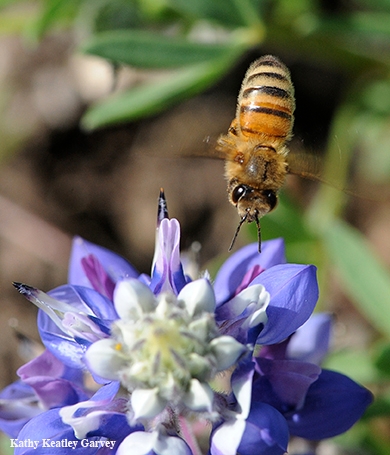Nectar microbes enhance floral allure
Last updated: 18 Oct, 2017
Research recently published in New Phytologist shows how pollinators get a buzz out of more than a flower's nectar.

A honey bee heading toward lupine. Photo by Kathy Keatley Garvey.
Nectar-living microbes release scents or volatile compounds too, and can influence a pollinator's foraging preference, according to the research, led by UC Davis community ecologist Rachel Vannette.
 "This extends our understanding of how microbial species can differentially influence plant phenotype and species interactions through a previously overlooked mechanism," Vannette said. "It's a novel mechanism by which the presence and species composition of the microbiome can influence pollination."
"This extends our understanding of how microbial species can differentially influence plant phenotype and species interactions through a previously overlooked mechanism," Vannette said. "It's a novel mechanism by which the presence and species composition of the microbiome can influence pollination."
"Broadly, our results imply that the microbiome can contribute to plant volatile phenotype. This has implications for many plant-insect interactions."
The paper may explain in part the previously documented extreme variation in floral volatiles that Robert Junker of University of Salzburg, Austria, and his team found.
In their study, Vannette's team first examined field flowers for the presence of nectar-inhabiting microbes, and in collaboration with co-authors Caitlin Rering and John Beck of the U.S. Department of Agriculture's Agricultural Research Service (USDA-ARS), characterised the gaseous headspace of four common fungi and bacteria in a nectar-like substance. Next, they examined the antennal and behavioural responses of honey bees to the chemical compounds. Finally, when they examined the scent of flowers in the field, they found that flowers which contained high densities of microorganisms also contained volatile compounds likely produced by those microbes, suggesting that microbial scent production can be detected and used by pollinators.
Although microbes commonly inhabit floral nectar, microbial species differ in volatile profiles. "Honey bees detected most of the microbial volatiles or scents that we tested," Vannette said, "and they distinguished the solutions of yeasts or bacteria based on volatiles only." This suggests that pollinators could choose among flowers based on the microbes that inhabit those flowers.
A yeast, Metschnikowia reukaufii, produced the most distinctive compounds (some shared with the fruity flavours in wine) and was the most attractive of all microbes compared. This yeast is commonly found in flower nectar and is thought to hitch a ride on pollinators to travel from one flower to the next. Its scent production may help it attract pollinators, which then help the yeast disperse among flowers.
Read the paper: Rering, C. C., Beck, J. J., Hall, G. W., McCartney, M. M. and Vannette, R. L. (2017) Nectar-inhabiting microorganisms influence nectar volatile composition and attractiveness to a generalist pollinator. New Phytologist. doi: 10.1111/nph.14809
This is an edited version of an original press release.
Mike Whitfield (@mgwhitfield)
Development Coordinator
New Phytologist